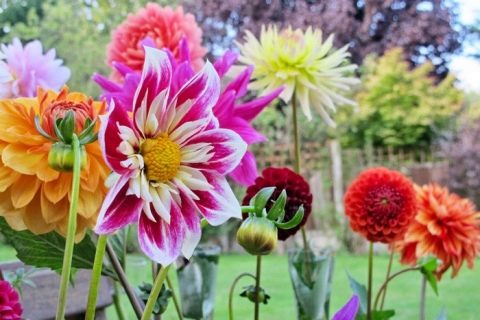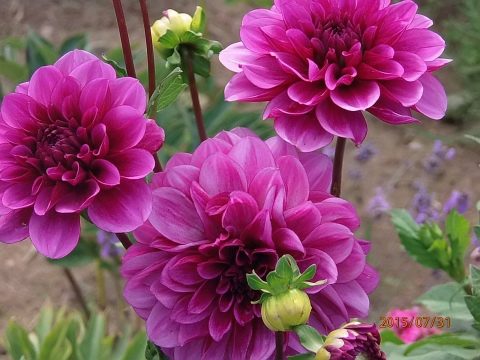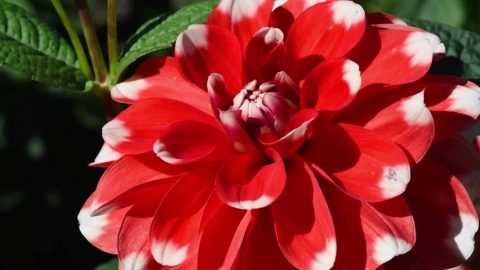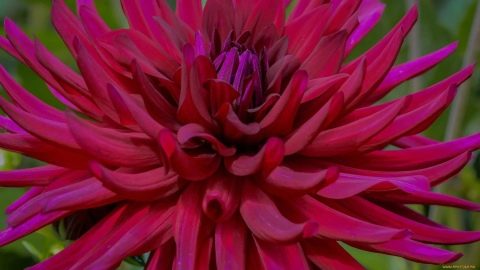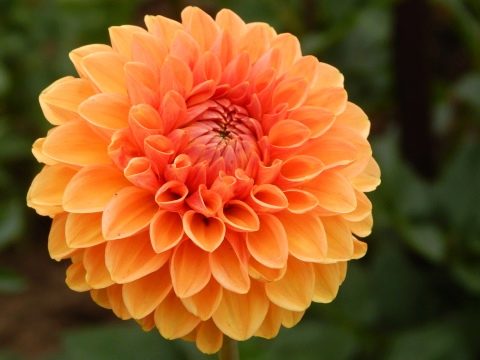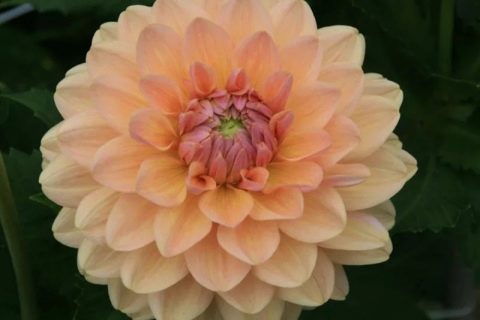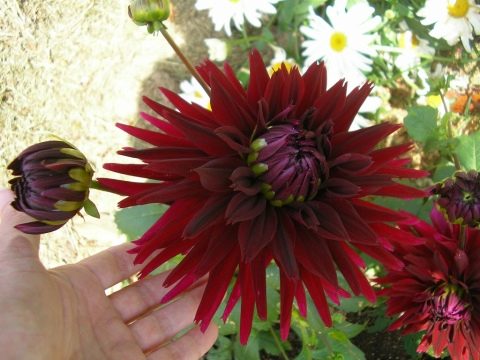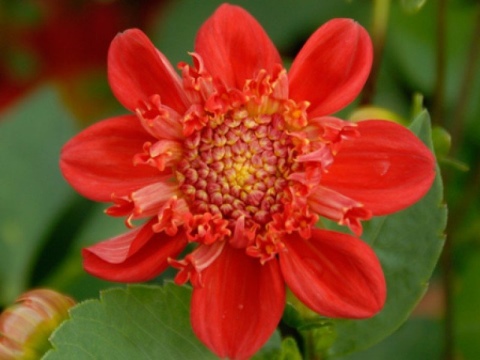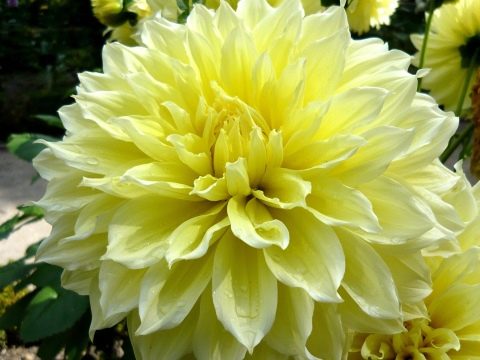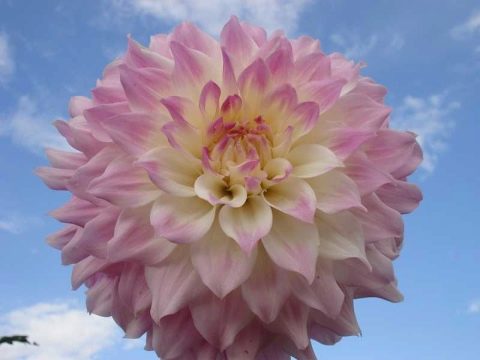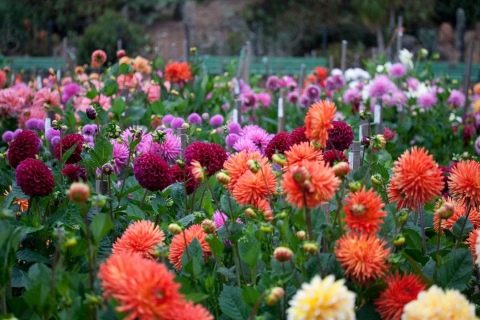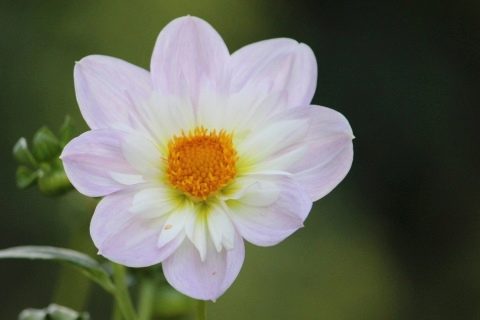Dahlia Bahama Red
Dahlia variety Bahama Red (see photo) - contrasting combination of red and white. The flower was created by breeders from Germany in the 80s of the last century. The Bahama Red variety has a peculiarity - in the southern regions it can even be grown as a perennial, because it has relatively high cold resistance rates. General description of the variety:
- stems grow up to 80-100 cm;
- inflorescences 10-14 cm in diameter;
- the main color is red;
- the tips of the narrow petals are snow-white.
There is a smooth transition between red and white on the petals. The brightness of this variety allows it to be planted in separate groups or combined with white, red and yellow varieties of dahlias.
Nymphaean dahlias are planted in spring - no earlier than mid-April. The distance between flowers is up to 50 cm, for tall varieties - 10 cm more. Flowers need sunlight, regular watering and fertilization. By following simple care rules, you can get lush and long flowering!
Dahlia Fleurel (Fleur)
The snow-white Fleur variety (see photo) with delicate, large flowers is the leader among dahlias grown to create bouquets. It is a tall variety with giant, single inflorescences on long peduncles. In some cases, pinching is used to obtain such a characteristic. The main characteristics of Dahlia Fleur:
- plant height up to 120 cm;
- branched stems;
- an abundance of deciduous green mass;
- double flower diameter up to 25 cm;
- petals are silvery-white, concave.
Fleur dahlias are planted in the second half of April and bloom in the second week of July. The flower retains freshness and beauty for a long time when cut. There are no specific requirements for care and cultivation.
The most demanded varieties
Peony, double and semi-double varieties of this plant are very popular, thanks to the large inflorescences, consisting of oblong petals, increasing from a pronounced center to the edges. This is a kind of "classic" dahlias for single planting and collectible flower beds. Breeders annually replenish the collection of this most common spectacular form of large flowers with new shade options. The most popular semi-double and terry varieties are white, burgundy, red-white, yellow, orange and red. The blue dahlia is no less effective.
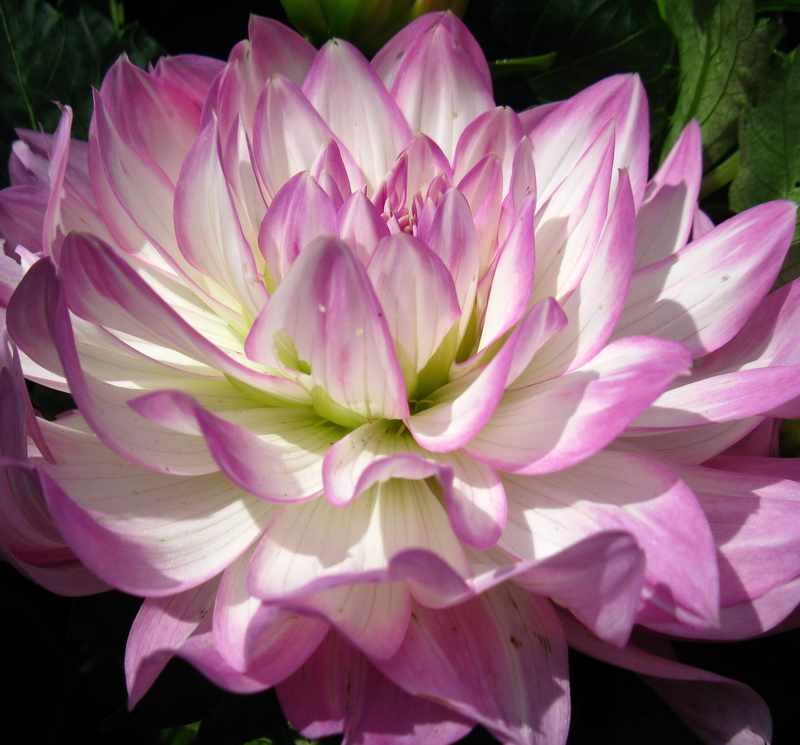
One of the latest hobbies of Dutch breeders is fringed flowers, which are in demand in catalogs. The characteristic reed-tubular inflorescences with fringed edges resemble asters. Red, blue and purple dahlias are often offered, as well as multicolored forms: Claire de Luna, Edinburgh, Mauna Luna, Stripe Ambition, Table Dancer, Akita, Myrtle Folly, etc. look good. They are always in demand in catalogs.
International classification of dahlias
In 1962, botanists from around the world gathered in Brussels to determine uniform classification methods. In 1969 the classifier was published. He's in action now. New varieties are introduced after registration with the RNS (International Registrar).
Simple
Inflorescences are not terry, 10 cm in diameter. Petals are arranged in 1 row. The height of the bushes is 0.7 m. Plants of the Sihgle-flowered group bloom profusely throughout the summer. They are usually propagated by seed. Simple dahlias are used for foreground decoration.
Anemone
Anemone-flowered varieties are disease resistant, very decorative. The shape of the terry (semi-double) inflorescences resemble garden anemones. The petals of the middle part are tubular. They are surrounded by 1-3 rows of marginal petals. Bushes come in different heights - from 0.3 m to 0.8 m.
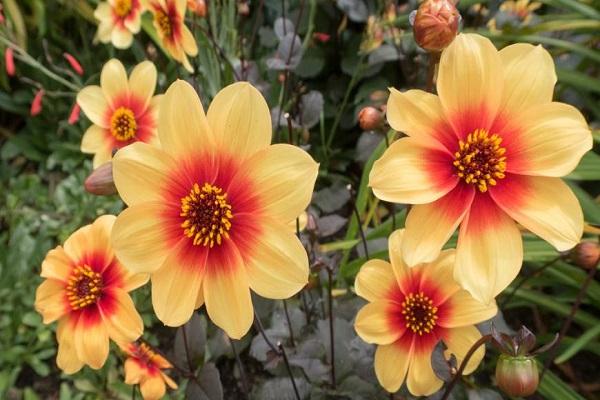
Collar
The inflorescences of Collerette Dahlias dahlias have a pronounced, convex core surrounded by petals arranged in 2 rows:
- large outdoor;
- shortened internal.
The diameter of the inflorescence baskets is 15 cm, the height of the bush is 1 m.
Peony
Semi-double baskets of peony perennials are formed by several rows of large oval petals. They surround a small central yellow disc. The diameter of the baskets is 10-20 cm, the bushes reach a height of 0.6-1.2 m.
Decorative
The representatives of this group have 2 types of petals. There are Decorative Dahlias varieties with regular, flat, rounded petals and others with wavy, as if deformed. In diameter, double inflorescences reach 10-20 cm, bushes grow up to 1-1.5 m.
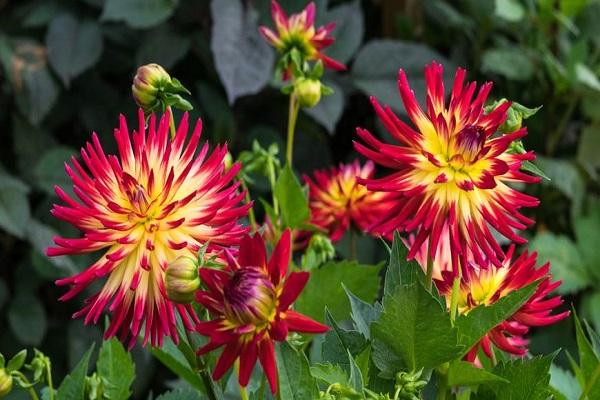
Spherical
The diameter of the baskets in spherical varieties is 10-20 cm. Terry baskets are similar in shape to a ball. The petals of the Ball Dahlias dahlias are twisted 50-75% of their length.
Pompom
Bushes 0.3-1.2 m high are covered with large leaves. The baskets look like a slightly flattened ball, they are small - up to 7 cm. All petals are of the same length and curl into tubes. Low-growing varieties of Pompon Dahlias are used to decorate the borders. Medium-sized forms are used in group garden plantings.
Cactus
The inflorescences are double-type, needle-like, 7-35 cm in diameter. Narrow petals are twisted over most of the length (65%). They are either straight, like Alain Mimoun, or curved, like Sarah Mae. The bushes of the cactus (Cactus Dahlias) dahlias are tall. Shoots grow up to 1.2-1.8 m.

Semi-cactus
The Semi-Cactus group includes forms that have characteristics similar to other species (decorative, cactus). Baskets are densely double, in cross-section from 5 to 25 cm. They consist of wide, pointed petals twisted by 25-50% of their length. In height, the plants of the Semi-Cactus group reach 0.4-1.3 m.
Nymphae
In the group of nymphaean (Waterlily Dahlias) varieties there are more than a thousand. All of them have lotus-shaped inflorescences, terry type. They are of the correct shape, outwardly reminiscent of a water lily flower. The size is 10-25 cm. The height of the nymphaean varieties is 0.9-1.2 m.
Mixed
Miscellaneous includes rare forms that are not of commercial interest. They are common in amateur gardens. Varieties from a mixed group delight flower growers with spectacular flowering, they are divided into 4 varieties:
- star-shaped;
- chrysanthemum;
- orchid;
- peony.
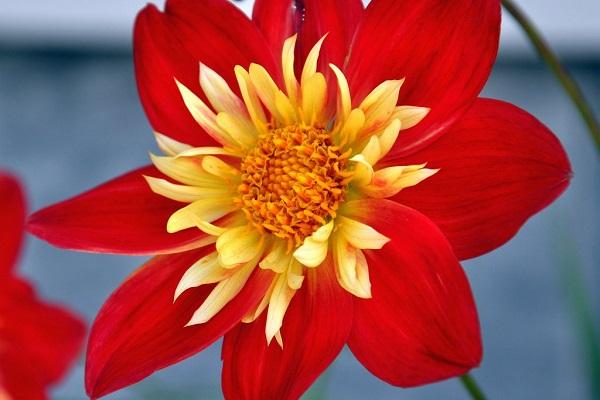
Application in medicine
Drinking may not always be safe
For people with any health problems, great care must be taken in the use of nectarine.
Diabetes
Nectarine
In chronic diabetes, the use of nectarine is not recommended. This is due to the rather high content of the glycemic index (42), sucrose, fructose.
If there is a suspicion of a disease, a mandatory consultation with a doctor is required before use.
Pancreatitis
Lola nectarine
People with this condition monitor their diet closely. The possibility of introducing nectarine into the diet depends on how severe the disease is and only after discussion with the doctor.
With a strict ban on sweet and sour fruits, it is not recommended to consume nectarine fruits.
Gastritis
Nectarine
Peach hybrid is an assistant in digestion, if the course of the disease is latent.
In the acute form of the disease, eating the fruit can aggravate the condition.
For the intestines
Nectarines
The peach cousin is a good help for the intestines. Thanks to its effect, contractility is improved.
Also, with the help of a fruit, like a brush, slags, growths from the walls of the intestines are swept out.
Constipation
Nectarine will help the body with a mild laxative effect
If there are difficulties with stool, motility of the digestive organs, the use of a nectarine hybrid will help the body with a mild laxative effect.
The main thing is not to eat fruit before bedtime, because because of this, the digestion process is activated, sleep will be disturbed.
Gout
Saturates joints with essential trace elements
It is recommended to use nectarine in the diet for people with sore joints. This will saturate the joints with essential trace elements and restore mobility to them.
It will also help break down salt deposits and remove excess sodium, which will greatly facilitate the course of the disease.
Haemorrhoids
Nectarine
Because of this inflammatory process, difficulties arise during bowel movements. To ease it, it is advised to eat nectarines.
But people with hypersensitivity should be very careful with these fruits, because use can lead to an exacerbation of the condition of nodes with inflammation
Cholecystitis
Nectarines
You can consume nectarine fruits for this disease after consulting with your doctor.
Carrots: description of the 28 best varieties, characteristics (Photo & Video) | + Reviews
What varieties to choose for decorating different parts of the garden
Giant dahlias are quite rare, they belong to decorative hybrid varieties. There are large inflorescences larger than a child's head, they reach 25 cm in diameter. They are planted where there is no strong wind that can break a heavy flower. These large-colored tall varieties (Maxi Le Baron) are used singly or in small groups at the fence.
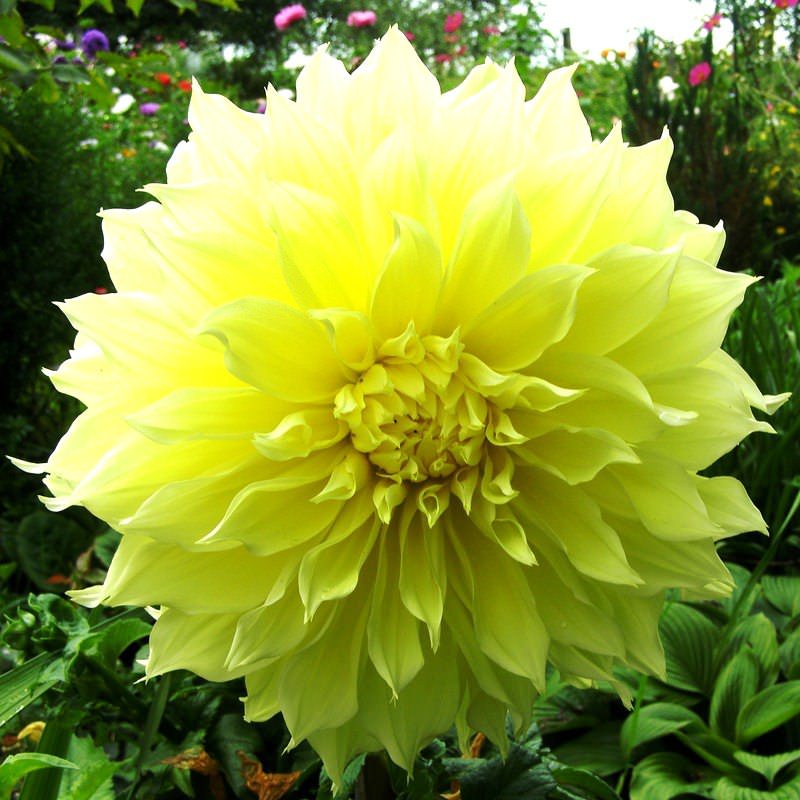
Smaller flowers, such as creamy Crazy Love (or "crazy love"), are most in demand by buyers who prefer to purchase planting material through catalogs. These highly decorative plants have a thick stem that is resistant to wind. They are common in Europe and in our country: in single and group plantings, a magnificent blue dahlia, as a hedge in 1-2 rows. Their flowers reach 20-23 cm.
The most popular among domestic gardeners are varieties with medium-sized inflorescences, within 15-20 cm, which are unpretentious, but differ in a variety of flower shapes and shades. They are well suited for planting in 1-2 rows, as a hedge or for decorating a chain-link fence. This is a favorite planting material for the collection of new varieties of dahlia Edinburgh, Vancouver, Madame Peak, Color Spectacle, Akita, Ankres, Vitemans Brest, Lucky, Vernost, etc.
The most popular are unpretentious plant varieties with smaller flowers, up to 12-15 cm in diameter, which are bred by domestic and Dutch breeders. They today decorate gardens and flower beds along with their larger relatives: Mystery Day, Evelyn, May Love, Alfred Grill, Moonlight (Sonata) and Dahlia Number 1.
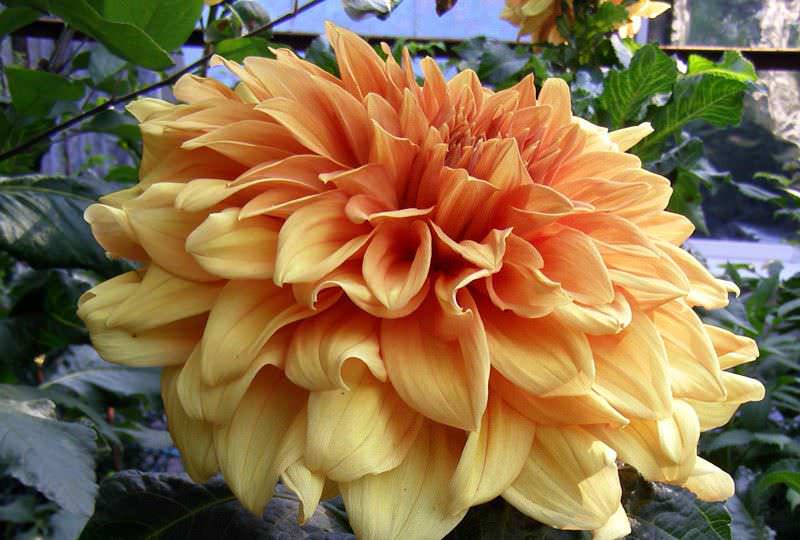
Miniature, luxuriantly flowering annuals and dwarf species with full inflorescences up to 10 cm in diameter belong to flower bed, balcony and border varieties. Compact bushes reach 60 cm in height, like the Vancouver dahlia. They are often used for planting in pots on glazed loggias in the northern regions, for summer and all-season gardening.
It is difficult to imagine flower beds and gardens without the Color Spectacle dahlia blooming from summer to October frosts. Curb varieties are classified:
- undersized up to 60 cm;
- medium height up to 1m;
- tall over 1.2m (like Evelyn).
The blue dahlia is used to decorate garden paths. This is a luxurious decoration of a garden or suburban home ownership. These flowers are also good because they rise by the middle of summer and bloom until frost, passing the baton to chrysanthemums. They are preferred on mixborders, where tulips and daffodils bloomed in spring. They are sown in the form of colored mixtures or only 1 variety of white dahlias is used. For these purposes, annual forms with familiar names that reproduce not by tubers, but by seeds are suitable: Minions, Preston Park or Funny Guys.

